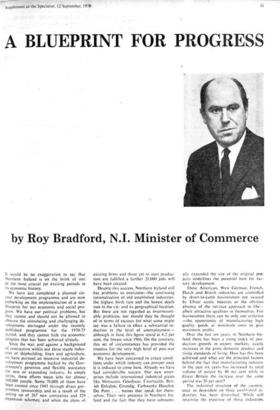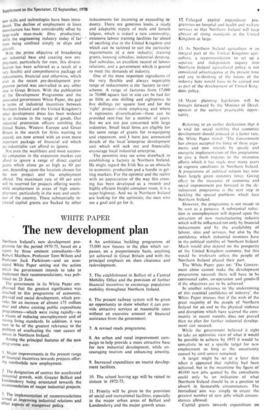A BLUEPRINT FOR PROGRESS
by Roy Bradford, N.I. Minister of Commerce
It would be no exaggeration to say that Northern Ireland is on the brink of one of the most crucial yet exciting periods in its economic history.
We have just completed a planned six- year development programme, and are now embarking on the implementation of a new blueprint for our economic and social pro- gress. We have our political problems, but they cannot and should not be allowed to obscure the stimulating and challenging de- velopments envisaged under the recently published programme for the 1970-75 period; and they cannot hide the economic progress that has been achieved already.
Since the war, and against a background of contraction within our three staple indus- tries of shipbuilding, linen and agriculture, we have pursued an intensive industrial de- velopment programme backed by the Gov- ernment's generous and flexible assistance for new or expanding industry. In simple terms, these efforts mean jobs for almost 100.000 people. Some 76.000 of them have been created since 1945 through direct gov- ernment sponsorship and as a result of the setting up of 267 new companies and 229 expansion schemes; and when the plans of existing firms and those yet to start produc- tion are fulfilled a further 21,000 jobs will have been created.
Despite this success, Northern Ireland still has problems to overcome—the continuing rationalisation of old established industries; the highest birth rate and the lowest death rate in the UK: and its geographical location. But these are not regarded as insurmount- able problems, nor should they be thought of in terms of excuses for what some might say was a failure to effect a substantial re- duction in the level of unemployment— although in June this figure stood at 6.2 per cent, the lowest since 1966. On the contrary, this set of circumstances has provided the impetus for the very high level of post-war economic development.
We have been concerned to create condi- tions under which industry can prosper once it is induced to come here. Already we have had considerable success. Our new enter- prises include international industrial giants like Monsanto. Goodyear. Courtaulds. Brit- ish Enkalon, Grundig, Farbwerke Hoechst. On Pont . . . names that speak for them-
, selves. Their very presence in Northern Ire- land and the fact that they have substanti-
ally expanded the size of the original pro- jects underlines the potential here for fac- tory development.
These American, West German, French, Dutch and British industries are controlled by down-to-earth businessmen not swayed by Ulster scenic beauties or the obvious absence of the rat-race approach to life— albeit attractive qualities in themselves. For businessmen there can be only one criterion —the opportunity of manufacturing high quality goods at minimum costs to give maximum profits.
Over the last ten years, in Northern Ire- land there has been a rising index ofpro- duction growth in export markets, yearly increases in the gross domestic product and rising standards of living. How has this been achieved and what are the principal factors behind the fact that manufacturing industry in the past six years has increased its total volume of output by 40 per cent while in Great Britain the increase over the same period was 26 per cent?
The industrial structure of the country. once so dependent on three established in- dustries. has been diversified. While still retaining the expertise of those industries,
new skills and technologies have been intro- duced. The decline of employment in linen manufacture has been considerably offset by large-scale man-made fibre production; while the engineering industry today is far' from being confined simply to ships and aircraft.
With the prime objective of broadening our industrial base anti creating new em- ployment, particularly for men, this diversi- fication has been achieved as a result of a very flexible and comprehensive package of inducements, financial and otherwise, which even in the recent pre-development pro- gramme period was unrivalled in any other area in Great Britain. With the publication of the Development Programme and the associated government White Paper, the gap in terms of industrial incentives between Northern Ireland and the United Kingdom's other development areas has been widened by an increase in the range of goods. Our industrial promotion officers combing the United States, Western Europe and Great Britain in the search for firms wanting to expand, are now armed with an even more important package of financial aid which no industrialist can afford to ignore.
Not even the wealthiest and most success- ful companies in the expansion market can afford to ignore a range of direct capital grants which alone go as high as 60 per cent, depending upon the location chosen for the new project and the employment offered. The maximum rate of 60 per cent will be reserved for projects offering worth- while employment in areas of high unem- ployment, particularly in the west and south- east of the country. These „substantially in- creased capital grants are backed by other
inducements for incoming or expanding in- dustry. There are generous loans, a ready and adaptable supply of male and female lallour, which is indeed a rare commodity; extensive labour training facilities far ahead of anything else in the United Kingdom arid which can be tailored to suit the particular requirements of a new industry; training grants, housing subsidies, industrial derating, fuel subsidies, an excellent record of labour relations; and a government which is geared to meet the demands of industry.
One of the most important ingredients of the very flexible and always negotiable range of inducements is the 'factory to rent' scheme. A range of factories from 17,000 to 70,000 square feet in size can be had for as little as one shilling and eightpence to five shillings per square foot and for the 'right' project—male employing and where it represents diversification—these can be provided rent-free for a number of years. But we are not just concerned with large industries. Small local firms are eligible for the same range of grants for re-equipping and expansion, and I have just announced details of the local enterprise development unit which will seek out and financially encourage local industrial enterprise.
The pessimist may see some drawback to establishing a factory in Northern Ireland. He might regard the Irish Sea as an obstacle to economic production and a hurdle in get- ting markets. For the optimist and the realist with an appreciation of the way this cross- ing has been developed as a smooth and highly efficient freight container route, it is a super-highway. And we in Northern Ireland are looking for the optimists; the men who see a goal and go for it.















































 Previous page
Previous page